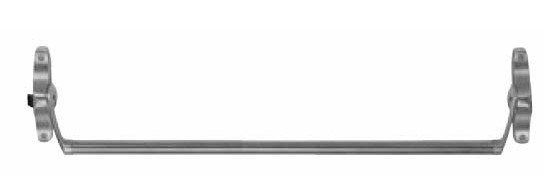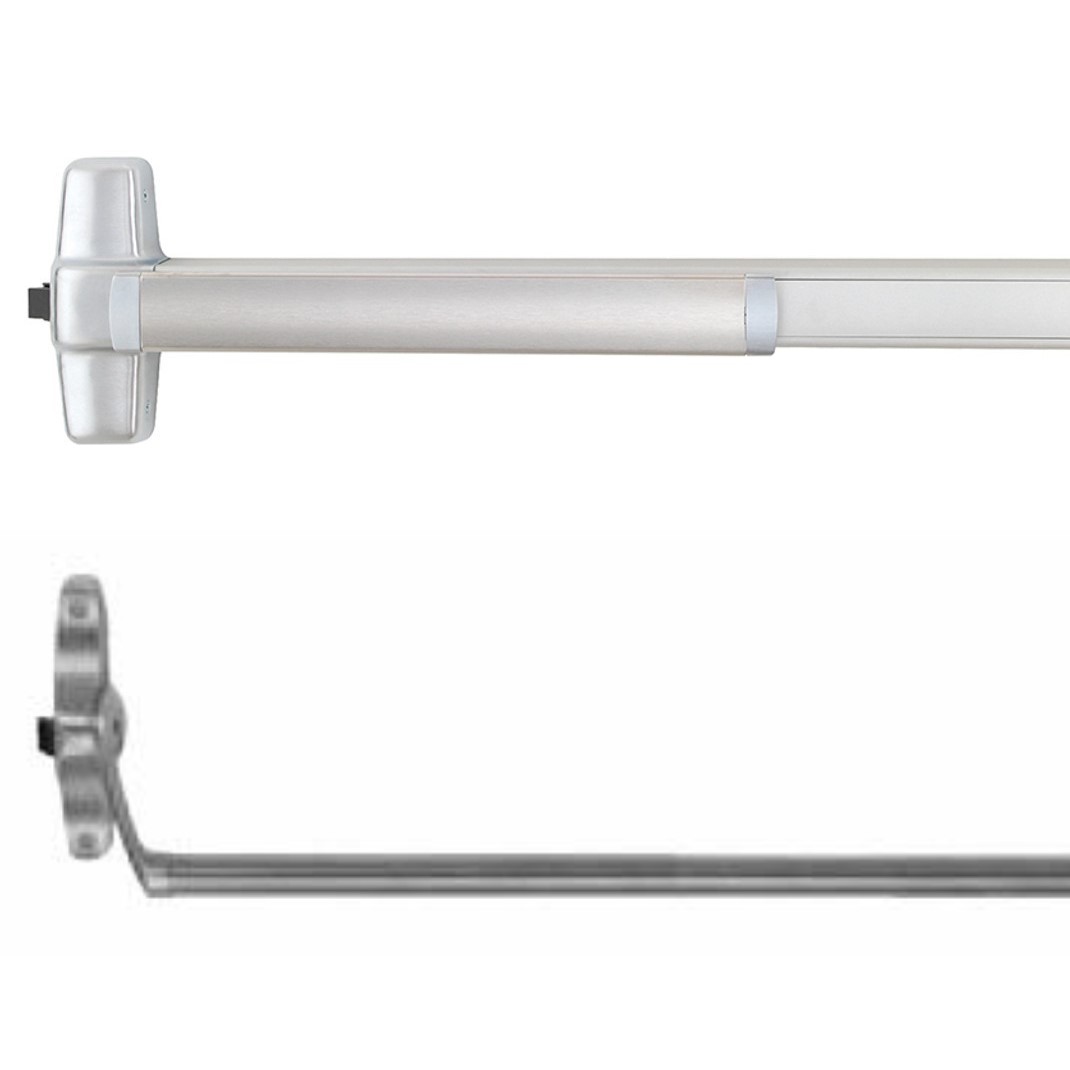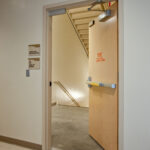Mark Kuhn’s latest post looks at the advantages of touchpad style panic hardware vs. crossbar style. Can you think of any other advantages or disadvantages to add?
~~~
I recently wrote a post about the IBC dropping the limitation on the maximum width of a door in a means of egress and how this could cause some issues in occupancies that require panic hardware. I offered up the crossbar style exit device as a possible solution for when the push pad/touchpad is not wide enough. Because the actuating portion of the panic hardware is required by code to measure at least half the width of the door, a door width greater than 48 inches causes problems for models with a maximum touchpad size of 24 inches.
As a follow-up, I thought I would offer some comparisons between push pad style panic hardware and the crossbar style, and why we prefer the push pad style device as the solution in most applications.
 Advantages of a crossbar device:
Advantages of a crossbar device:
The look…When I think of cross bar style panic hardware…I think, “Old.” In fact, when I talk about this hardware, I often catch myself calling it the “old style crossbar type device,” to which most architects and owners reply, “Do they still make them?” But “the look” is probably the main reason this type of panic hardware is still used. As you can imagine, if an owner/architect is designing a restaurant, lounge, club, etc. around a certain era, then the crossbar device gives them the look they want and still meets the code requirements.
The fit…The second most common application where I specify a crossbar panic is on doors that are not flush. Sometimes the face of a door may have either a vision light or a raised panel that will prevent a touchpad style panic from mounting on the door without a shim kit. This happens a lot when you are using either a wood stile and rail door or a fiberglass door. The design of the crossbar panic allows it to work on a door surface that may not be perfectly smooth, and some designers prefer this look for full-glass doors.
Wide actuating bar…As I discussed in my earlier post, crossbar panic hardware could become more common since the maximum width of an egress door is no longer limited by code.
~~~
 Advantages of a push pad (AKA touchpad) style device:
Advantages of a push pad (AKA touchpad) style device:
Visual Indicators: Last month, I had a post about indicators and how important they have become in hardware. With a touchpad type device we have the ability to incorporate this feature into a panic. Whether you want to see if the panic is dogged or see if the outside trim is locked, we now can visually verify these things without having to physically check the door. I’m sure this feature has added a level of security and convenience in many educational occupancies as well as other use cases. I can tell you that I hardly ever specify panic hardware with the dogging option or trim that is capable of being locked from the inside, without also specifying a status indicator. #KnowItsLocked
Electronics: This is a Biggie! We often joke that every kind of hardware can be electrified nowadays, but nothing illustrates this more than a panic bar. As far as I know, there are only two electrical options available on a crossbar style device, a request-to-exit switch and outside trim that can be electrically locked or unlocked. But with a push pad device that’s just the “tip of the iceberg.” I can monitor whether the touchpad is depressed or if the latch bolt is retracted. I can retract the latch bolt without ever touching the device and I can unlock the outside trim to allow access. I can use the panic hardware to unlock an electromagnetic lock for egress, and I can incorporate an alarm to discourage people from using the device unless it’s an emergency. I can even delay people from going through the door (for 15 or 30 seconds depending on the occupancy, the applicable code and the AHJ). We can also accomplish some of these functions pneumatically, just in case you’re worried about an electrical spark. I’m sure I have left something off the list (and I’m also sure that you loyal iDH fans will let me know what it is ). But you get the point, a push pad device means more options, especially when it comes to electronics.
 More Functionality: I covered dogging when I addressed indicators, but it bears mentioning again in this section. With a push pad style device we can have cylinder dogging, a feature unavailable on a crossbar style device. In my career I’ve literally held thousands of keying meetings and I’ve always thought it was a little crazy to spend time worrying about how to lock the outside of a panic, when anyone with a 99¢ Allen wrench could unlock all the doors from the inside. So, you could call me a strong proponent of cylinder dogging. A more recent function, only available in a touchpad style device, is the ability to lock the outside trim from inside the room with the door closed. We need this for assembly spaces where we want to “shelter in place” and specifically when the door is fire rated. When we have a fire rated door, we can’t use mechanical dogging because that would keep the door from positive latching. So, in order to lock the door from the inside, this new function allows an authorized person to lock the outside of the door from inside the room.
More Functionality: I covered dogging when I addressed indicators, but it bears mentioning again in this section. With a push pad style device we can have cylinder dogging, a feature unavailable on a crossbar style device. In my career I’ve literally held thousands of keying meetings and I’ve always thought it was a little crazy to spend time worrying about how to lock the outside of a panic, when anyone with a 99¢ Allen wrench could unlock all the doors from the inside. So, you could call me a strong proponent of cylinder dogging. A more recent function, only available in a touchpad style device, is the ability to lock the outside trim from inside the room with the door closed. We need this for assembly spaces where we want to “shelter in place” and specifically when the door is fire rated. When we have a fire rated door, we can’t use mechanical dogging because that would keep the door from positive latching. So, in order to lock the door from the inside, this new function allows an authorized person to lock the outside of the door from inside the room.
Harder to chain: I didn’t say impossible to chain because Lori has literally hundreds of Wordless Wednesday and Fixed-it Friday pictures that prove that “where there’s a will there’s a way.” With that said, crossbar style panic hardware can be very tempting to secure with chains, cable locks, or other creative means, and we want to avoid that to help ensure free egress.
Can anyone think of other advantages or disadvantages that I might have missed?
You need to login or register to bookmark/favorite this content.










Fortunately, making wider push pad type exit devices is somewhat less complicated than rocket science. It’ll probably be harder to convince the suits to pony up the money for in-house engineering evaluations, testing (and possibly new tooling), not to mention adding a few SKU’s to the price book, than it will be to actually do the work.
Cross bar makes it difficult to identify lock edge in a panic situation
1010.1.1.1 Projections Into Clear Width
There shall not be projections into the required clear opening width lower than 34 inches above the floor or ground. Projections into the clear opening width between 34 inches and 80 inches above the floor or ground shall not exceed 4 inches.